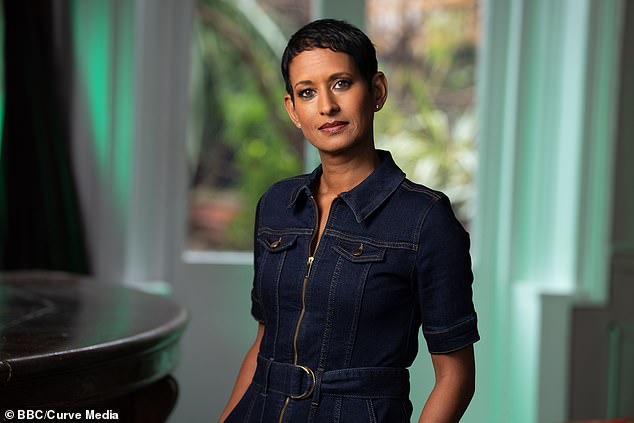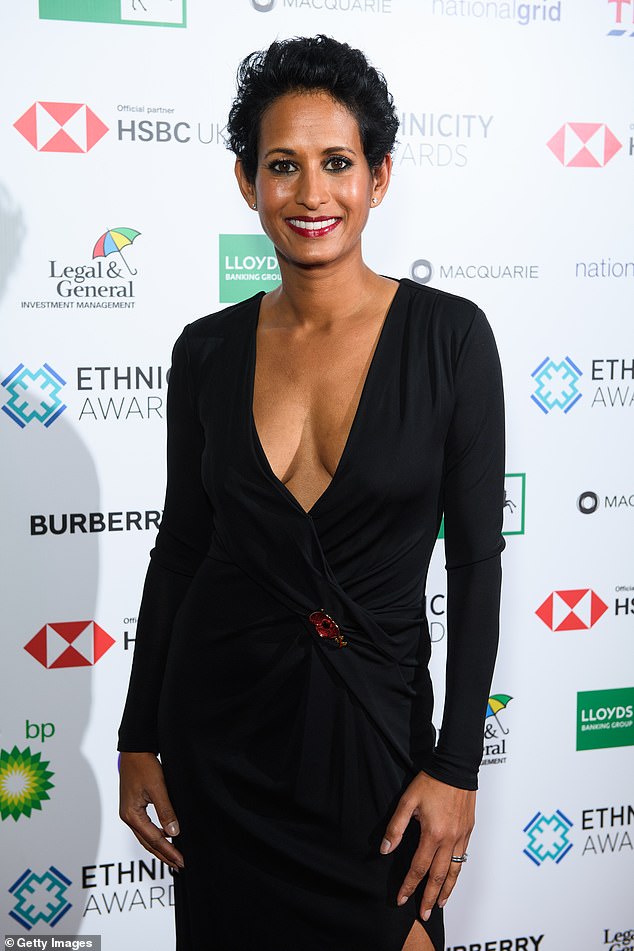BBC presenter Naga Munchetty has revealed how she lived in excruciating pain with undiagnosed adenomyosis for well over three decades.
The condition, which affects one in ten women in the UK, occurs where the lining of the uterus starts growing into the muscle in the wall of the womb.
In many cases, adenomyosis can cause extremely painful periods and heavy bleeding during the menstrual cycle, alongside intense pelvic pain and bloating.
However, despite these difficult symptoms, a considerable number of women – like Naga – go undiagnosed for years, and struggle to find helpful treatments.
The presenter, 50, told The Sunday Times that living with excruciating periods for 32 ‘makes you angry’.
She said: ‘If you are second-guessing that you are not strong enough to be a woman, that you are weaker than all the other women because you’re told it’s all normal, everyone’s going through it, you second-guess other parts of your life.’
Naga has since opted to get sterilised in a bid to stop the pain, after her decision to get the contraceptive coil fitted in 2017 left her screaming in agony.
‘I felt like it was my only option’, she said.

BBC presenter Naga Munchetty has revealed how she lived in excruciating pain with undiagnosed adenomyosis for well over three decades
But what is adenomyosis – and what are the treatment options?
Adenomyosis is a condition which occurs when the lining of the uterus begins growing into the muscle in the wall of the womb, causing severe pain during periods.
The condition is more common in women over the age of 30 – and those who have had children – but it can affect anyone who has a menstrual cycle.
Typically, symptoms include extremely painful periods and heavy bleeding, but sufferers can also experience pelvic pain, significant bloating and pain during sex.
However, the NHS does note that some women with the condition will experience no symptoms.
The condition causes similar affects to endometriosis, a separate condition where tissue alike to the lining of the womb grows in other places, such as the ovaries or fallopian tubes.
Those who fear they might have adenomyosis – or other similar conditions – are advised to seek medical advice if their periods become painful or irregular, they experience pain during sex or have been bloated for upwards of three weeks.
Though there is no cure for the condition, there are a number of treatment options.

In many cases, adenomyosis can cause extremely painful periods and heavy bleeding during the menstrual cycle, alongside intense pelvic pain and bloating

The BBC presenter lived with painful heavy bleeding, vomiting, fainting and severe aching every two and a half weeks for 32 years before a private doctor finally gave her a diagnosis (pictured with co-star Charlie Stayt)
These include the IUS – the intrauterine system, or hormonal coil – which things the lining of the womb and can make periods lighter and much less painful.
Sufferers can also try other types of hormonal contraception, like the progestogen-only pill, the combined pill or the contraceptive patch, to help alleviate symptoms.
For some women, medicines such as tranexamic acid or NSAIDs – nonsteroidal anti-inflammatory drugs – can also be helpful.
However, if these are ineffective, it is possible to turn to surgery.
The NHS explains this could be a total hysterectomy – to remove the uterus entirely – or a surgery to remove the lining of the womb. This is called a endometrial ablation.
But some, like Naga, could instead opt for sterilisation to end their excruciating pain.
The broadcaster explained that she didn’t want a hysterectomy, as she didn’t believe it would eradicate her pain entirely.
Though typically found in the uterus, adenomyosis can affect additional areas.
Instead, in 2019, Naga opted for a keyhole surgery that blocked or cut her fallopian tubes. This is sometimes called tubal ligation or ‘getting your tubes tied’.
‘I knew I didn’t want children and I didn’t want to be reliant on hormones or the regimen of the pill because it didn’t fit with my lifestyle,’ she said.
‘I felt like it was my only option.’
Today, Naga takes the hormonal contraceptive pill to prevent periods and is on HRT for the perimenopause. However, she still lives with adenomyosis to this day.







